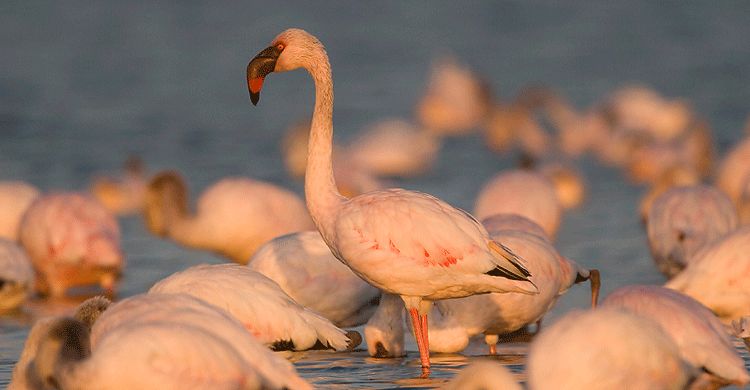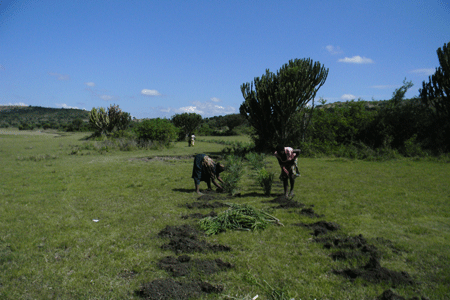Lesser Flamingo Conservation Project Successfully Completed in Uganda

Lesser Flamingos (Phoeniconaias minor) © Mark Anderson
Bonn, 29 October 2014 - An AEWA-funded waterbird conservation project has been successfully completed in Uganda. Focusing on the conservation of the Lesser Flamingo in the Queen Elizabeth conservation area and adjacent buffer zones, the project was implemented by NatureUganda in close collaboration with the Katwe Tourism Information Center (KATIC), a local conservation group that concentrates on guiding tourism and raising awareness on conservation issues. Financial support was provided by the Government of the United Kingdom in the framework of the AEWA Small Grants Fund (SGF).
The project activities started in April 2013 and were implemented over a period of 14 months, with a focus on lakes Munyanyange and Kasenyi which form part of a network of saline crater lakes, located in South-Western Uganda. The main activities included the rehabilitation of degraded land, promoting alternative livelihood activities, waterbird monitoring and awareness-raising for waterbird conservation. These measures addressed problems resulting from human activity and intervention, particularly in relation to the salt extraction industry, which have resulted in increased pressures on natural resources through fuel wood exploitation, fishing and livestock grazing.
Land restoration activities involved planting of a hedge of Euphorbia tirucalli, an indigenous shrub, around Lake Munyanyange and its environs. The hedge will help to curb cattle invasion and soil erosion, thereby restoring the habitat for the benefit of over 70,000 Lesser Flamingoes and other bird species that use the site for breeding, feeding and roosting. This activity took into consideration the uses of the rehabilitated area by the local community, for instance, access to the community playground was maintained.

In order to increase knowledge on waterbird conservation, a workshop on bird monitoring was conducted in the capital city of Kampala. It aimed at strengthening the network of volunteers involved in NatureUganda’s Bird Population Monitoring (BPM) program which directly feeds into the International Waterbird Census (IWC), managed by Wetlands International. In addition, three guides from the Katwe community and four members of KATIC benefitted from a training on waterbird identification and monitoring. The training was coupled with practical field exercises on bird counting in various Queen Elizabeth National Park sites, including the Munyanyange and Kasenyi salt lakes, Kazinga Channel, the Kikorongo, Bagusa, Maseche, Nshenyi and Kashaka crater lakes and Shoebill swamp. These bird counts were conducted as a direct support to the IWC during the January 2013 and June 2014 count periods.
The 2014 World Migratory Bird Day (WMBD) campaign was used to promote awareness on waterbird conservation issues. A national awareness-raising event was hosted at the KATIC grounds in the Katwe-Kabatooro town council, reflecting the global theme of “Destination Flyways: Migratory Birds and Tourism”. This event, jointly organized by NatureUganda, the KATIC, Uganda Wildlife Authority and Uganda Wildlife Society, highlighted the contribution of bird-related tourism to the economic development of Katwe-Kabatooro town council and Uganda as a whole. In response to the community’s priorities, a monthly clean-up campaign entitled “Keep Katwe Clean” was initiated during this WMBD celebrationand involves cleaning the Katwe-Kabatoro town and the environs of the Katwe Salt Lake. To sustain this campaign, two community groups and five schools were supported with sanitation materials and tools Other awareness raising activities included the production and distribution of brochures, posters and stickers with a focus on raising awareness on the Lesser Flamingo and its habitats.
.gif)
Eco-tourism initiatives were promoted through a two-day exchange visit by 12 members of the Mabamba Wetland Eco-Tourism Association (MWETA) and Lutembe Wetland Users Association (LWUA) to the Katwe Eco-tourism Center and the Queen Elizabeth National Park. This rare learning experience enabled participants to exchange ideas, success stories and lessons learned with regard to the management and conservation of their environment as a tourist destination. This activity focused on promoting eco-tourism as an alternative income-generating activity by these communities around the conservation area.
In order to further minimize pressure on the natural resources in and around the Queen Elizabeth Conservation Area, a five-day training workshop on alternative economic activities was conducted to support the livelihood of the communities living around the conservation area. A group of 20 KATIC members were trained on various aspects of organic back-yard farming, mushroom growing and other greening initiatives. As a contribution to this project, the community members constructed a mushroom house for the group and raw materials were provided such as oyster mushroom spawns and vegetable seedlings.
The full involvement of the local communities in the design and implementation of the project activities contributed significantly to the buy-in and support of these activities. KATIC was encouraged to include more conservation schemes in their routine environmental education programme in order to contribute to the sustainability of the project outcomes. Furthermore, a Memorandum of Understanding (MOU) between KATIC and the Katwe-Kabatooro town council was renewed in the framework of this project, thereby providing the mandate for the management of tourism activities and biodiversity conservation in the town council.The UNEP/AEWA Secretariat congratulates NatureUganda and KATIC on the successful implementation and completion of the project and hopes that the project activities can be sustained. The Secretariat would also like to express its gratitude to the Government of the United Kingdom for providing financial support for this project in the framework of the AEWA Small Grants Fund.
For more information on the project please contact Mr. Michael Opige, Acting Executive Director of NatureUganda at michael.opige@natureuganda.org
About the AEWA Small Grants Fund
The AEWA Small Grants Fund became operational in 2010 and has since benefitted 11 conservation projects from 11 African countries with funds amounting to over EUR 200,000. The next call for proposals will be launched in 2015. For more information on the AEWA Small Grants Fund please visit the AEWA website.
Nature Uganda
NatureUganda (NU) is the branch of the East Africa Natural History Society (EANHS) in Uganda, the oldest conservation organization in East Africa. NatureUganda has the mission to promote understanding, appreciation and conservation for nature. For more information visit http://www.natureuganda.org/
KATIC
The Katwe Tourism Information Centre (KATIC) was formed in 2005 with the mission of conserving the surrounding natural resources for sustainable tourism in order to enhance economic and conservation benefits for Katwe community.
By Melanie Jakuttek and Evelyn Moloko.
Last updated on 06 November 2014


